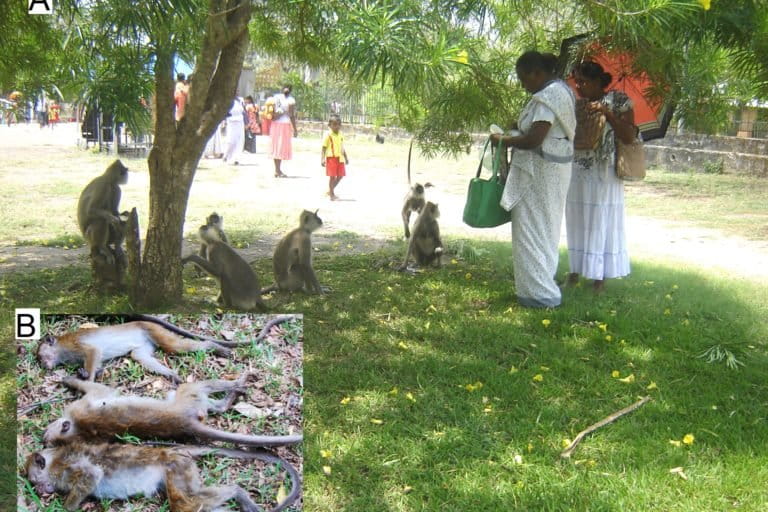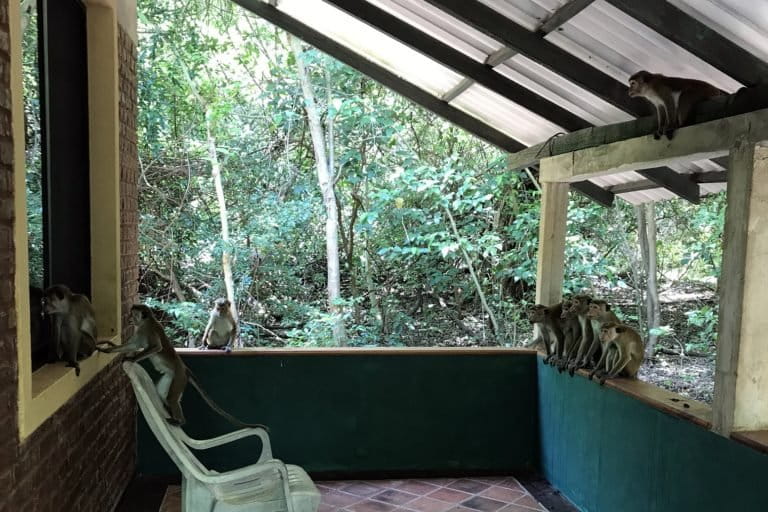- The feeding of monkeys on religious and cultural grounds by communities in north central Sri Lanka is turning the animals into pests that raid kitchens and farms.
- Where human-sourced food is available to monkeys, their populations have swelled, as opposed to those groups of monkeys reliant on a more natural diet.
- Proposed long-term solutions involve creating exclusive habitats supporting all biota, and creating public awareness, researchers say.
Some residents of rural Polonnaruwa in north central Sri Lanka had little or no clue why monkeys were regularly raiding their kitchens and rummaging through garbage bins. All they knew was that the intelligent and mischievous primates were stealing food from their kitchens, damaging their homes and attacking crops.
For centuries, villagers in Sri Lanka have lived in a balanced relationship with monkeys. Villagers chased monkeys attempting to raid and monkeys respected humans. Raiding success was minimal and monkey populations were stable.
What has changed in the last 30 years or so is the growth, especially of local tourists, who leave food scraps around the environment, especially at pilgrimage sites, and feed the monkeys — essentially creating pests for local villagers. The proliferation of guesthouses and hotels has contributed to the problem of excess environmental garbage because of ineffective refuse control. Elephants, monkeys, pigs, peacocks, crows and rats are attracted to human food sources.
The monkeys in particular were turning into pests, and chasing them away became a daily ritual for the villagers.
A new study now suggests it was this human action, among a slate of other factors, that contributed to the growth of the monkey communities in the area and the increase in frequency of human-monkey conflicts, or HMC. The findings, the authors say, can help inform policies to mitigate future instances of HMC.
“What people did not appear to understand is that the kitchen food scraps thrown into the garden or intended for domestic animal feed attracted [the monkeys],” said primatologist Wolfgang Dittus, lead author of the study published in the journal Folia Primatologica, and director of the Smithsonian Primate Biology Program in Sri Lanka.

“As crops and fruiting trees are only available seasonally, food scraps that are discarded daily appear to have great pull,” Dittus said. “And it’s less work for the primates to wait for food scraps or raid a kitchen without having to search for the same amount of food over two to three days.”
The study draws from half a century of records of increased conflicts between humans and primates in Sri Lanka, and captures people’s perceptions of primates in 13 locations near Polonnaruwa and their relationship with the primates sharing the habitat in the dry zone rural villages.
It focuses on four species — the toque macaque (Macaca sinica),tufted gray langur (Semnopithecus priam), purple-faced langur(Semnopithecus vetulus) and the slender loris (Loris lydekkerianus nordicus) — and also considers solutions to human-monkey conflicts.
Monkey densities in the dry zone varied from less than one per square kilometer, in arid regions with scant vegetation, to more than 100 monkeys per square kilometer where the plant life was more abundant, diverse and moist. Crucially, monkey densities were greater at sites where the primates had access to human-sourced or anthropogenic food.
Residents complained of more encounters with the macaques and gray langurs, less with the purple-faced langurs, and least with the loris, this frequency being a key factor when considering them as pests.
“Species and habitat differences in ecology are important considerations when proposing solutions to HMC and the lack of public understanding of the underlying causes of HMC hindered solution-seeking,” Dittus said.
Eighty percent of the villagers surveyed favored translocation of troublesome monkeys from their properties to protected areas, while 1 percent wanted them eliminated. These responses, Dittus said, reflected a lack of understanding of primate population ecology and the various triggers.
With shrinking habitats, there’s a reduction in natural food sources for wildlife, replaced by more anthropogenic ones.
“Natural food sources, such as fig trees (Ficus spp.) were rare on human properties, and the monkeys visited these food sources only if they were bearing young leaves or fruit,” the study notes.
Villagers agreed that what might have attracted wild animals to their properties was human-sourced foods, such as crops, fruit trees, and cooked and uncooked kitchen food stores, scraps intended for domestic animals, and edible garbage, as well as water from open drains, leaky taps or wells.
For some people, feeding monkeys is a considered a meritorious act. Monkeys are seen by many as representing the Hindu deity Hanuman, and thus enjoy a cultural and religious significance not afforded to many other species of wildlife. Yet this act of feeding them as a show of faith has contributed to the swelling of the primates’ population, the study says.

“Not only have numbers of monkeys increased in the conflict zone but their home ranges have expanded primarily by dispersing out of the forest to occupy progressively more human habitation,” it adds.
“The ‘human habitation’ used to be just few years earlier, unoccupied by humans. It was forest land that the monkeys had not yet occupied, but with human incursion and conversion to food rich properties, it attracted monkeys – to what used to be forested area not occupied by that group, Dittus said.
Seeking a solution
While the affected residents overwhelmingly felt that translocating the monkeys was key to ending the problem, Dittus said it’s not a practical solution.
In neighboring India, which experiences a similar problem, the practice of trapping and transferring monkeys for release away from an HMC trouble spots is cited as a useful example. But the study notes an absence of empirical follow-up about the actual fate of the translocated monkeys or the impact on humans and indigenous wildlife in the translocation sites. A key concern, Dittus said, is that such translocations are likely to take place within the arid zone where cultivation and human habitation are difficult: “These are not suitable habitats for primates or any other species because such habitats do not support species’ adaptation and survival.”

To achieve long-term conservation goals and control pest behavior, the best practice is to set aside exclusive habitats for the monkeys, he said. Though people felt protected areas were better for monkeys, the preservation of good habitats and creating exclusive habitats for all species would be the best solution, Dittus said.
“People understand their cultural heritage but what they need to be taught is their natural heritage, which can, in turn, build awareness on how to stop doing what turns monkeys to pests.”
Citation:
Dittus, W., Gunathilake, S., & Felder, M. (2019). Assessing Public Perceptions and Solutions to Human-Monkey Conflict from 50 Years in Sri Lanka. Folia Primatologica, 90(2), 89-108. doi:10.1159/000496025
Banner image of macaques grooming, courtesy of Barney Wilczak.
